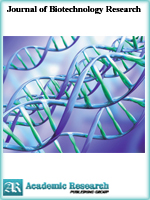Journal of Biotechnology Research
Online ISSN: 2413-3256
Print ISSN: 2413-8878
Print ISSN: 2413-8878
Quarterly Published (4 Issues Per Year)

Archives
Volume 11 Number 3 July 2025
Comparative Analysis of DNA Extraction Protocols for Molecular Study of Fall Armyworm
Authors: Oduoye, O.T. ; Olajire, O.E. ; Fajimi, O. et. al.
Pages: 16-23
DOI: doi.org/10.32861/jbr.113.16.23
Abstract
Fall armyworm (FAW) is a polyphagous and ravenous pest, destroying maize plants world over. It was first observed in Nigeria in the year 2016 and since has spread and engulfed the farming system in the continent of Africa. Several species have begun to spring up with very similar destructive pattern and this necessitates more objective molecular characterization and genomic research works toward integrated pest management practices. Many research works have proposed different DNA extraction methods that could provide quality DNA for molecular downstream analysis. This study objectively compared and modified four conventional protocols that are cost effective, rapid and yield good quality DNA for further studies. The CTAB (Cetyl Trimethyl Ammonium Bromide) method, CTAB-PVP (Cetyl Trimethyl Ammonium Bromide-Polyvinyl pyrolidone - PVP) method, SDS (Sodium Dodecyl Sulfate) method and Urea method. The result of the Analysis revealed significant variation in DNA purity at 1% (p<0.01) level with values ranging from 1.83 ± 0.2154 (Urea) to 2.05 ± 0.2123 (SDS). Also, DNA yield or concentration among the protocols at 1% (p<0.01) level with values ranging from 784.77 ± 388.80 (PVP) to 2854.08 ± 1274.87 (CTAB). This indicates that CTAB has the best yield while PVP has the least yield. We concentrated on the CTAB yield and beefed up the washing method for higher quality. Mitochondria Cytochrome oxidase 1 (mtCO1) region was used to amplify the DNA and the product sequenced. Hence, the CTAB protocol yielded the highest DNA suitable for downstream analysis.



